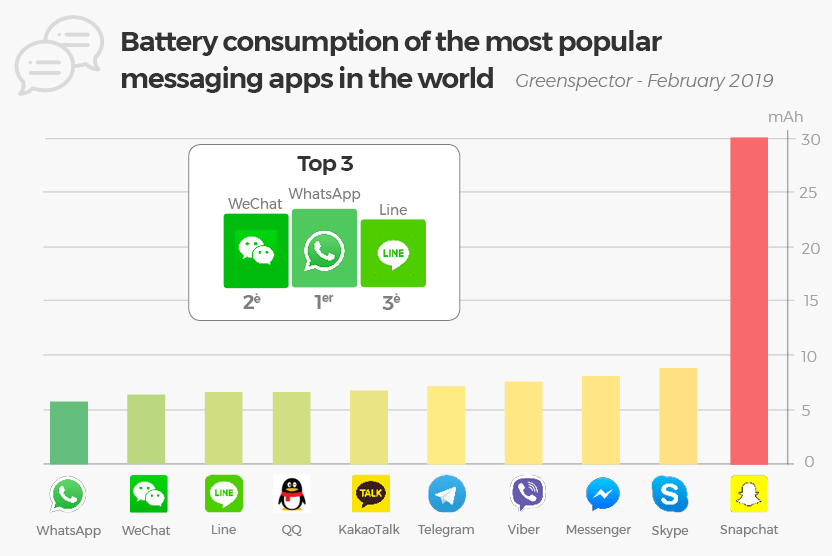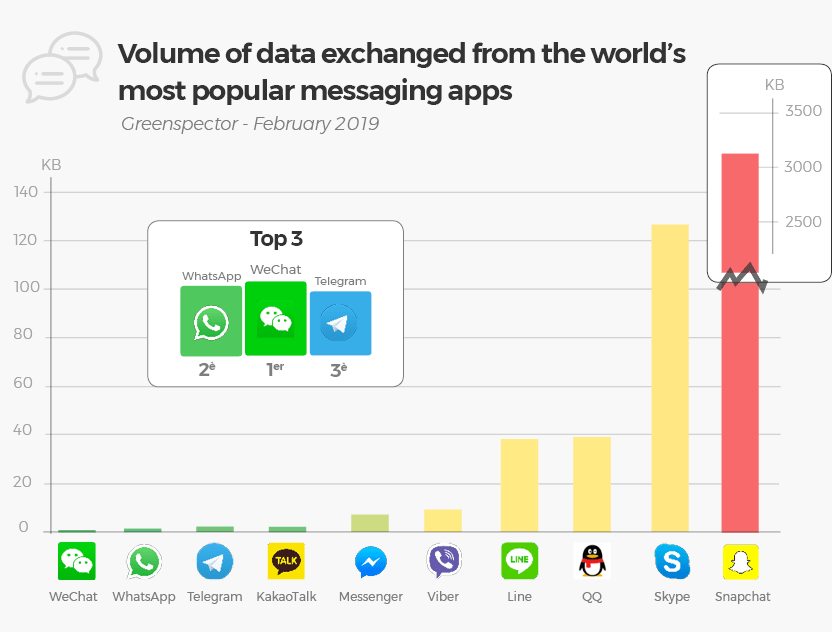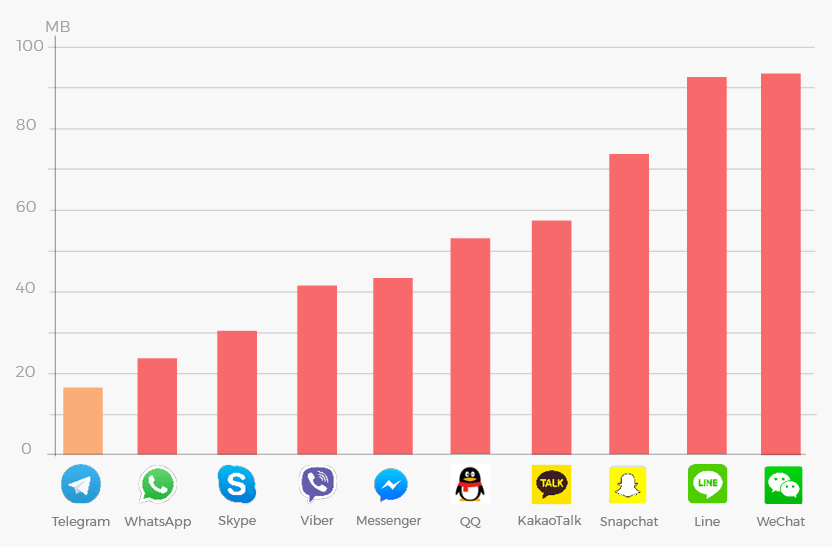Which direct messaging application should I choose?
A few weeks ago, the Statista institute published the most used messagings app ranking. A market dominated by two giants: Facebook (Messenger owner and WhatsApp) and Chinese Tencent (QQ and WeChat).
SMS are increasingly being replaced by instant messaging services running over the data network and offering a multitude of additional and trendy features (HD, GIF, video, etc.) but also more consuming for the batteries as well as for data exchanged. A user spends an average of 2 to 3 hours on his smartphone and 20% of that time, connected to messaging and communication applications. These messaging applications are today the most used apps by mobile users, which gives them a strong responsibility on our batteries, our data packages but also on their ecological and economic impacts for the end user.

We chose to study these ten applications in order to compare their performance as well as their energy and resource consumption. Find the details of these applications (versions, size APK …) at the end of the article.
Results
Battery consumption ranking
WhatsApp (5.65 mAh) is the most virtuous application here, followed closely by WeChat (6.33 mAh) and Line (6.49 mAh).

There is no significant disparity between applications except the Snapchat app, the average is 7 mAh (excluding Snapchat), 1.24 times higher than the best app in this ranking (WhatsApp). We note that QQ is very close to the podium (6.50 mAh).
At the end of the pack, we find the application Snapchat, the most power-draining app and this is explained quite easily: when it’s launched, the camera is automatically opened. Its battery consumption during the launch and inactivity phases in the foreground and in the background are also the highest and lead average. It consumes 4x more than the average. It also exchanges a lot more data than the other applications: 3.12 MB is still 135 times more than the average of the panel.
Projection of battery life time
{{< gsp-image title=”” src=”/assets/img/articles/2019-02-15-messagerie/battery-projection.png” >}}
By using the WhatsApp application continuously, you can count on +9 hours of battery life. On the other hand if you use Snapchat, count a little less than 2 hours of autonomy.
Amount of data exchanged
Regarding the amount of data exchanged, the top 3 is this time around: WeChat, WhatsApp and Telegram.

The Line application is penalized by a higher data consumption than most competitors: a management of exchanged data that could be improved. It lost its third place in this ranking and is in 7th position. It’s the same for the QQ app that loses a few places. On the other hand, Messenger, KakaoTalk and Viber earns some ranking positions.
Conclusion
Overall on our battery and data consumption tests, WeChat & WhatsApp proved themselves to be the best messaging apps. In economic terms, if your data plan is limited, it will cost you less with both applications. In addition, beyond autonomy and to stay on this economic and ecological angle, you will also extend the life of your battery.
Application Details
| Application | Version | Downloads | Playstore Grade | App Weight (MB) |
|---|---|---|---|---|
| KakaoTalk | 8.2.1 | 100 000 000+ | 4.3 | 57.5 |
| Line | 9.1.1 | 500 000 000+ | 4.2 | 92.7 |
| Messenger | 200.0.0.14.103 | 1 000 000 000+ | 4.1 | 43.4 |
| 7.7.6 | 10 000 000+ | 3.7 | 53 | |
| Skype | 8.37.0.98 | 1 000 000 000+ | 4.1 | 30.3 |
| Snapchat | 10.50.0.0 | 500 000 000+ | 4.1 | 74 |
| Telegram | 5.3.0 | 100 000 000+ | 4.4 | 16.6 |
| Viber | 10.0.0.12 | 500 000 000+ | 4.4 | 41.5 |
| 7.0.0 | 100 000 000+ | 4.2 | 93.4 | |
| 2.19.17 | 1 000 000 000+ | 4.4 | 23.9 |
The average size of applications in our panel is 52.63 MB. We notice that the most greedy storage applications of your smartphone are: WeChat and Line. On the contrary, Telegram and WhatsApp are the least impacting for your storage space.

Note: Find our other comparative applications articles: Messenger vs Messenger Lite, Facebook vs Facebook Lite or Instagram vs Instagram Lite.

Kimberley DERUDDER has been digital marketing manager at Greenspector for more than 5 years. Kimberley graduated with a master’s degree in Marketing – Communication and specialized in Inbound Marketing after her first two years at Greenspector. Today in charge of the animation of the marketing, social media and lead generation strategy, she also takes care of app comparisons and battles.
